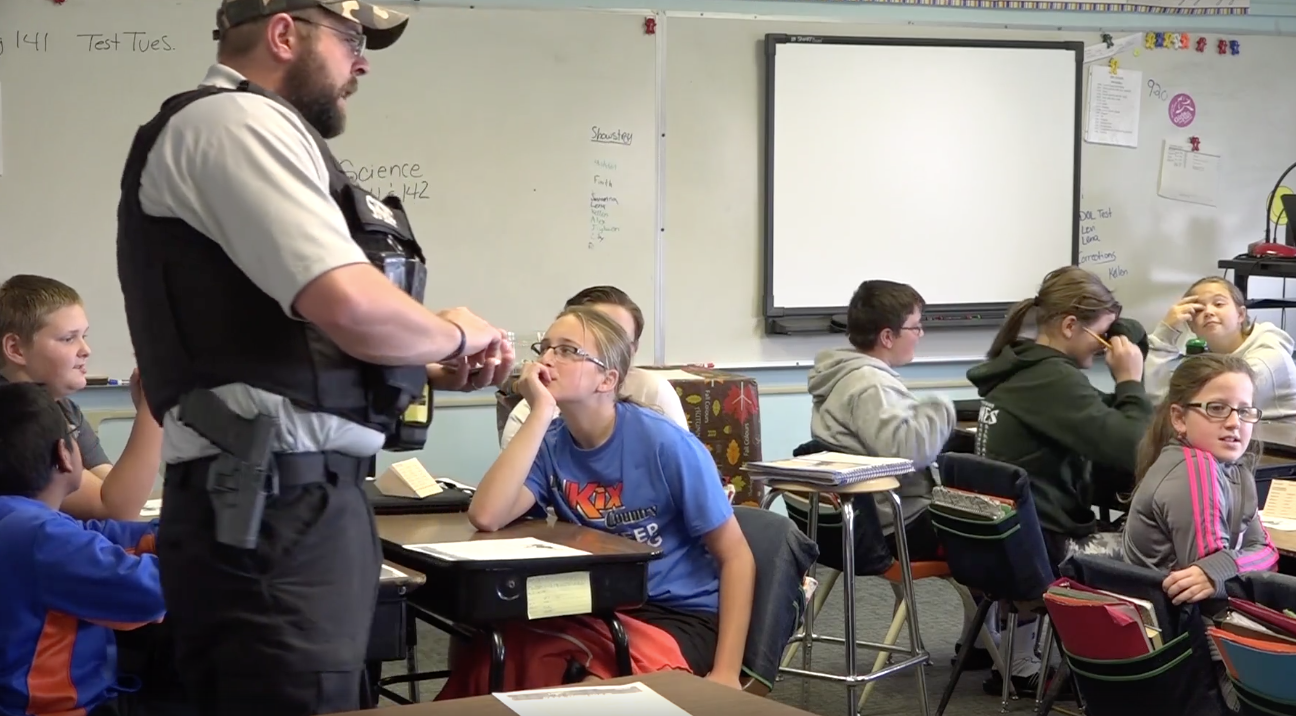|
This week D.A.R.E. students are learning how to communicate effectively.
A big part of D.A.R.E. is teaching strategies that not only help students with choices regarding drugs and alcohol but to take those same strategies into other life lessons and decisions. The decision model is Define, Assess, Respond and Evaluate, which can be used in many situations for people of all ages. There are many ways to have effective communication. What are some different ways we can communicate effectively? Students used various example situations to help build confident communication. Example situations included how to convince a friend to go outside and play instead of play video games inside, requesting a friend to help work on a school project, and how to meet new friends at a new school. The students define the challenge or opportunity and assess the choices and consequences, both positive and negative. Next week, we will move on to Lesson 7 with D.A.R.E., which is about responsibility reporting bullying.
1 Comment
This week D.A.R.E. students are working making safe and responsible choices.
A big part of D.A.R.E. is teaching strategies that not only help students with choices regarding drugs and alcohol, but to take those same strategies into other life lessons and decisions. The decision model is Define, Assess, Respond and Evaluate, which can be used in many situations for people of all ages. Example situations taught this week included how to respond when a friend asks to copy your homework after a school activity kept them out late. Another situation was whether a friend who likes basketball should try out for the team since he’s not sure he’s good enough to make the team. The students define the challenge or opportunity and assess the choices and consequences, both positive and negative. Next week, we’ll move on to Lesson 4 with D.A.R.E., which is about resistance straegies. * * * Antelope County’s D.A.R.E. program runs through donations from the community. The graduation t-shirts and booklets are purchased using those donations. If you’d like to offer a donation to D.A.R.E., take cash or mail a check it to the Antelope County Sheriff’s Department in Neligh. Please specify in the memo that this is for the D.A.R.E. program. This week D.A.R.E. students are working on the facts and health effects of alcohol and tobacco use.
Some of the effects of alcohol use are loss of coordination, poor judgment, memory loss, loss of self-control and slow reflexes. Among the effects of tobacco use are heart disease, more colds and upper respiratory problems, lung cancer, mouth cancer, tooth loss and more. Students also started start the dare decision making model (DDMM) and focused on define. In this lesson, they defined the problem of different situations. For example, situations included watching a friend’s sibling take a beer from the refrigerator or seeing them smoking. They also had to identify “risky” situations. In this exercise, students worked with a partner to come up with examples of the situations. Next week, we’ll move on to Lesson 3 with D.A.R.E., which is about making safe and responsible choices. * * * Antelope County’s D.A.R.E. program runs through donations from the community. The graduation t-shirts and booklets are purchased using those donations. If you’d like to offer a donation to D.A.R.E., take cash or mail a check it to the Antelope County Sheriff’s Department in Neligh. Please specify in the memo that this is for the D.A.R.E. program. As students go through the 10-week D.A.R.E. program, readers will have the opportunity to learn more about their program right here on the Antelope County News.
This weekly column will go through each lesson for the next 10 weeks as it’s taught to the students. This program focuses on the D.A.R.E. decision making model practice, which stands for Define, Assess, Respond, Evaluate. 1. Define: Describe the problem, challenge or opportunity. 2. Assess: What are your choices? 3. Respond: Make a choice. Use the facts and information you have gathered. 4. Evaluate: Review your decision. Did you make a good choice? Youth and adults can use the D.A.R.E. decision making model numerous times every day. The situation talked about in this lesson is playing a soccer team. The team depends on you as a goalkeeper, but you’ve been invited to your best friend’s birthday party at the same time as the big game. To go to the party, you would miss the game. How do you decide what to do? That’s when the D.A.R.E. decision making model come into play and helps the youth make a decision. Next week, we’ll move on to Lesson 2, which tackles some tough topics for both youth and parents. * * * Antelope County’s D.A.R.E. program runs through donations from the community. The graduation t-shirts and booklets are purchased using those donations. If you’d like to offer a donation to D.A.R.E., take cash or mail a check it to the Antelope County Sheriff’s Department in Neligh. Please specify in the memo that this is for the D.A.R.E. program |
John ShaverA Deputy with the Antelope County Sheriff's Department, John teaches DARE and will take readers through the 10-week course via this series. Neligh-Oakdale 5th graders are in DARE each spring. The other Antelope County schools combine 5-6th graders in DARE every other year. |
News That Matters To Antelope County - Your News. Your Way. Every Day!
© Pitzer Digital, LLC




 RSS Feed
RSS Feed


